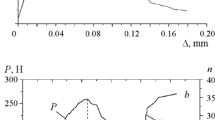The applicability of various criteria for evaluation of the fracture toughness of a discretely reinforced carbon–carbon composite material for friction purposes is considered. The values of the K1c, J1c, Jc and COD criteria of fracture toughness are calculated. The distribution of the fields of displacements and deformations on the surface of specimens is determined by the method of numerical correlation of digital images with the use of a VIC-3D system. The stress fields are calculated.







Similar content being viewed by others
References
E. Fitzer, “The future of carbon-carbon composites,” Carbon, 25(2), 163 – 190 (1987).
J. D. Nuckley and D. D. Edie, Carbon-Carbon Materials and Composites, Noyes, New Jersey (1993), p. 289.
T. Windhorst and G. Blount, “Carbon-carbon composites: a summary of recent developments and applications,” Mater. Design, 18, 11 – 15 (1997).
G. Savage, Carbon–Carbon Composites, Chapman and Hall, London (1993), p. 389.
A. S. Fialkov, Carbon, Interlayer Compounds and Composites Based on It [in Russian], Aspekt-Press, Moscow (1997), 717 p.
V. Kostopopoulos, Y. P. Markopoulos, Y. Z. Pappas, and S. D. Peteves, “Fracture energy measurements of 2-D carbon–carbon composites,” J. Eur. Ceram. Soc., 18, 69 – 79 (1998).
M. Sakai, T. Miyajima, and M. Inagaki, “Fracture toughness and fiber bridging of carbon fiber reinforced carbon composites,” Comp. Sci. Technol., 40, 231 – 250 (1990).
Xian-Kui Zhu and James A. Joyce, “Review of fracture toughness (G, K, J, CTOD, CTOA) testing and standardization,” Eng. Fract. Mech., 85, 1 – 46 (2012).
H. Hatta, Y. Kogo, H. Asano, and H. Kawada, “Applicability of fracture toughness concept to fracture behavior of carbon,” Jap. Soc. Mech. Eng. J., Ser. A, 42(2), 265 – 271 (1999).
D. R. Moore, A. Pavan, and J. G.Williams, Fracture Mechanics Testing Methods for Polymers, Adhesives and Composites, Elsevier (2001), p. 388.
M. S. Aly-Hassan, H. Hatta, S. Wakayama, M. Watanabe, and K. Miyagawa, “Comparison of 2D and 3D carbon/carbon composites with respect to damage and fracture resistance,” Carbon, 41, 1069 – 1078 (2003).
Y. Kim, “Effect of postpeak tension-softening behavior on the fracture properties of 2-D carbon fiber reinforced carbon composite,” J. Mechan. Sci. Technol., 23, 8 – 13 (2009).
Jun-Ming Su, Zhi-Chao Xiao, Yong-Qiong Liu, et al., “Preparation and characterization of carbon_carbon aircraft brake materials with long service life and good functional properties,” New Carbon Mater., 25(5), 329 – 334 (2010).
T. Krause, Y. Tushtev, D. Koch, and G. Grathwohl, “Interlaminar mode I crack growth energy release rate of carbon/carbon composites,” Eng. Fract. Mech., 100, 38 – 51 (2013).
V. V. Kostikov, A. V. Demin, V. V. Kulakov, et al., “Termar” friction carbon/carbon materials,” in: Recent Problems of Production and Service of Carbon Products [in Russian], Digest, Chelyabinsk (2000), pp. 211 – 212.
A. V. Chichinadze, A. Yu. Albagachiev, V. D. Kozhevnikova, et al., “Assessment of friction and wear characteristics in domestic friction composite materials in loaded aircraft brakes,” J. Frict. Wear, 30(4), 261 – 270 (2009).
ASTM E1820. Standard Test Method for Measurement of Fracture Toughness.
Hailiang Li, Hejun Li, Jinhua Lu, et al., “Improvement in toughness of carbon/carbon composites using multiple matrixes,” Mater. Sci. Eng. A, 530, 57 – 62 (2011).
Prasad N. Eswara, S. Kumari, S. V. Kamat, et al., “Fracture behaviour of 2D-weaved, silica-silica continuous fibre-reinforced, ceramic-matrix composites (CFCCs),” Eng. Fract. Mech., 71, 2589 – 2605 (2004).
A. G. Paradkar, Ravali N. Shanti, and Prasad N. Eswara, “Mechanical behaviour of 2D and 3D weaved SiC-matrix, carboncontinuous fibre-reinforced composites. Pt. 2. Fracture toughness under static loading conditions,” Eng. Fract. Mech., 182, 52 – 61 (2017).
A. A. Stepashkin, D. Yu. Ozherelkov, Yu. B. Sazonov, et al., “Assessment of fracture toughness of a discretely reinforced carbon/carbon composite material,” Metalloved. Term. Obrab. Met., No. 4, 51 – 58 (2015).
T. Hashida and Victor C. Li, “New development of the J-based fracture testing technique for ceramic-matrix composites,” J. Amer. Ceramic Soc., 77(6), 1553 – 1561 (1994).
Author information
Authors and Affiliations
Corresponding author
Additional information
Translated from Metallovedenie i Termicheskaya Obrabotka Metallov, No. 4, pp. 64 – 70, April, 2018.
Rights and permissions
About this article
Cite this article
Stepashkin, A.A., Ozherelkov, D.Y., Sazonov, Y.B. et al. Criteria for Evaluating the Fracture Toughness of Carbon–Carbon Composite Materials. Met Sci Heat Treat 60, 266–272 (2018). https://doi.org/10.1007/s11041-018-0271-9
Published:
Issue Date:
DOI: https://doi.org/10.1007/s11041-018-0271-9




